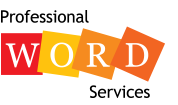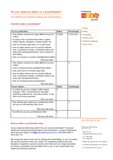
A proofreader is essential for accurate publication
Proofreading is an essential checking stage in the process that takes the written word from the writer to its audience. A professional proofreader adds the polish that takes a report or publication from 90% to as close to 100% as possible in such a detail-oriented field.
Spelling, punctuation or grammatical errors or content inconsistencies in material that goes to clients or the public reflect poorly on your organisation. Using a skilled professional proofreader will ensure that your important documents are ready to impress their audience.
To assist our clients with a speedy turnaround, our professional proofreaders will work nights and weekends to help you reach your production or release deadline – at no extra charge for the priority. Our proofreaders specialise in proofreading for business, publishing houses, tertiary institutions, government departments, professional associations, consultancies, and any organisation that produces written communication for public consumption.
We are Melbourne based, but through the resources of the Internet and modern communications options we work with clients Australia wide.
Learn more about the differences between proofreading and editing
Professional proofreaders for assignments in Melbourne and around Australia
Our professional proofreaders will proof magazines, reports, manuals, guides, submissions, papers, readers, proposals, public documents, websites — any topic, any format and anything that is going to clients or the public.
Examples of the range of documents/publications we have proofread recently include:
- A major university’s degree and diploma guide (94 A4 pages)
- Children’s readers for an international airline (four x 44 A5 pages)
- A leading bimonthly agricultural magazine (52 A3 pages)
- An emergency services magazine (52 A4 pages)
- Product catalogues for a major international brand (two, 12 A4 pages and 20 A4 pages)
- Annual reports for a public health network (48 A4 pages) and a large charity (32 A4 pages)
- A new website for an international education organisation (100 pages, online test site).
What do proofreaders do?
The traditional role of a proofreader is to check written material after it has already been through an editing process. The editor (copy editor/subeditor or internal team member) does the ‘heavy lifting’ in making required changes and corrections to the writer’s article (report, document, etc.) in the original word-processing file.
The proofreader gets to read the material once it has been laid out into its final format, such as an A4 desktop published magazine/report or a Word document template, with its accompanying headings, photos, tables and other graphics. (The document is usually supplied as a PDF, which is printed and marked up.)
The proofreader looks for what might have been missed during the editing and will carry out double-checks and spot checks on things such as unusual spellings on proper nouns (e.g. place names), plus fact checks on things that may look questionable.
What proofreaders look for in text
The list of what a proofreader looks for is long and includes:
- editing ‘strays’ (e.g. sentences that end in the middle of nowhere, or words that have been left in that should have been removed, or commas that should have been deleted when text was removed)
- missing, incorrect or inconsistent publication style (e.g. capitalisation, bullet point style)
- grammar, spelling and punctuation errors (particularly use of apostrophes as possessives and incorrect contractions)
basic word errors, such as missing or errant ‘s’, ‘ing’ or ‘ed’ endings - missing words (e.g. ‘a’, ‘the’) and incorrect words that are spelt correctly (e.g. if/of)
- incorrect symbols
- correct usage (to style) of the hyphen, en dash and em dash marks
- consistency of writing tense
- use of singular and plural
- errors in tables, figures and other graphics
- hyphenation, orphans and widows, and rivers of white
- plus much more.
Generally, our proofreaders proof within PDF files, marking corrections and suggested changes using Acrobat’s ‘Comments’ mode. The proof is emailed back, usually with some notes pointing out aspects of the proofing or highlighting problems. Proofreading can be done in a Word file (tracked), although this would usually be classed as editing. (Editing and proofreading share many characteristics and professional proofreaders are often skilled editors, too.)
Professional Word Services’ proofreaders are Melbourne based and we work with clients all over Australia.
Is there a proofreading service you need that is not covered here? Please email or call to discuss your proofreading needs. If we can’t help you, then there is a good chance we will know other specialist proofreaders who can.

